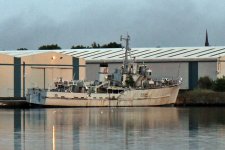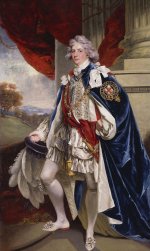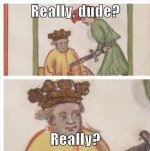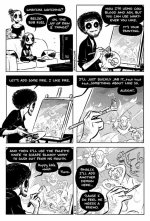-
Features
-
Friends of IIDBFriends Recovering from Religion United Coalition of Reason Infidel Guy
Forums Council of Ex-Muslims Rational Skepticism
Social Networks Internet Infidels Facebook Page IIDB Facebook Group
The Archives IIDB Archive Secular Café Archive
You are using an out of date browser. It may not display this or other websites correctly.
You should upgrade or use an alternative browser.
You should upgrade or use an alternative browser.
Images that make you laugh
- Thread starter gmbteach
- Start date
Cycad
Member
Ha George 6, last emperor (of India)
Thanks Jayjay
Thanks Jayjay
Hermit
Cantankerous grump
1) Are the Prince's and Duke's medals attached to some sort of stiff backing that allows the entire row to be hooked onto their jackets as a unit, or does the Duke have some of his pinned to his coat at the armpit?
2) There is no doubt some Auncient and Royal reason why the Duchess's sash is in the "opposite" direction. I wonder what it is.
3) Does the Duke's garter have an extra embellisment hanging down is calf, or did the Prince get his on askew?
4) (Not to mention the oddity that the Duchess is married to the Prince and the Duke is married to the Queen...)
Keith&Co.
Contributor
- Joined
- Mar 31, 2006
- Messages
- 22,444
- Location
- Far Western Mass
- Gender
- Here.
- Basic Beliefs
- I'm here...
Yes. It's a common practice, a light but stiff metal row with the medals permanently affixed, so they are never in the wrong order.1) Are the Prince's and Duke's medals attached to some sort of stiff backing that allows the entire row to be hooked onto their jackets as a unit,
Gone are the days of the less-convenient 2x4 of medals, worn like a shoulder-holster of fame, and thank the lords for that. As it is, he can't dance with the queen without snapping his legacy across her face a few times...
Cycad
Member
It's George IV in 1790, when he was the Prince of Wales. The painter was John Hoppner.
View attachment 14394
Thanks Hermit
I wonder why George IV hats with these nice ostrich feathers went out of fashion.
And unlike Charles he has the golden fleece around his neck.
bilby
Fair dinkum thinkum
- Joined
- Mar 6, 2007
- Messages
- 40,341
- Gender
- He/Him
- Basic Beliefs
- Strong Atheist
hurtinbuckaroo
Contributor
angelo
Deleted
repoman
Contributor
bilby
Fair dinkum thinkum
- Joined
- Mar 6, 2007
- Messages
- 40,341
- Gender
- He/Him
- Basic Beliefs
- Strong Atheist
According to an old friend of mine: "It is a different order... The three are wearing the Lessor George on the sash of the Garter Order. They are all Knights of the Garter of various degrees. CPB is wearing the Dame Grand Cross of the Royal Victorian Order."
...
2) There is no doubt some Auncient and Royal reason why the Duchess's sash is in the "opposite" direction. I wonder what it is.
...
He hastened to add: "They are pretty irrelevant as far as I am concerned. My knowledge of their little pin badges is through my interest in Historical Reenactment, not any devotion to this bunch of very ordinary people".
Thomas II
Contributor
4321lynx
Veteran Member
According to an old friend of mine: "It is a different order... The three are wearing the Lessor George on the sash of the Garter Order. They are all Knights of the Garter of various degrees. CPB is wearing the Dame Grand Cross of the Royal Victorian Order."
...
2) There is no doubt some Auncient and Royal reason why the Duchess's sash is in the "opposite" direction. I wonder what it is.
...
He hastened to add: "They are pretty irrelevant as far as I am concerned. My knowledge of their little pin badges is through my interest in Historical Reenactment, not any devotion to this bunch of very ordinary people".
https://en.wikipedia.org/wiki/Royal_Victorian_Order
The Royal Victorian Order is a dynastic order of knighthood established in 1896 by Queen Victoria. It recognises distinguished personal service to the monarch of the Commonwealth realms, members of the monarch's family, or to any viceroy or senior representative of the monarch
Now, what distinguished personal service might that lady have performed and to whom and how many times?
bilby
Fair dinkum thinkum
- Joined
- Mar 6, 2007
- Messages
- 40,341
- Gender
- He/Him
- Basic Beliefs
- Strong Atheist
According to an old friend of mine: "It is a different order... The three are wearing the Lessor George on the sash of the Garter Order. They are all Knights of the Garter of various degrees. CPB is wearing the Dame Grand Cross of the Royal Victorian Order."
He hastened to add: "They are pretty irrelevant as far as I am concerned. My knowledge of their little pin badges is through my interest in Historical Reenactment, not any devotion to this bunch of very ordinary people".
https://en.wikipedia.org/wiki/Royal_Victorian_Order
The Royal Victorian Order is a dynastic order of knighthood established in 1896 by Queen Victoria. It recognises distinguished personal service to the monarch of the Commonwealth realms, members of the monarch's family, or to any viceroy or senior representative of the monarch
Now, what distinguished personal service might that lady have performed and to whom and how many times?
Never mind that; I want to know what Charlie and Phil did in combat to get all those medals. Or are they things like the 'Got out of bed within five minutes of reveille twice in a row cross' and the 'Remembered to put trousers on before boots star'?
Jon Osterman
Member
Never mind that; I want to know what Charlie and Phil did in combat to get all those medals. Or are they things like the 'Got out of bed within five minutes of reveille twice in a row cross' and the 'Remembered to put trousers on before boots star'?
To be fair, Charles did fly helicopters in the navy. And then he commanded this ship:

C_Mucius_Scaevola
Veteran Member
4) (Not to mention the oddity that the Duchess is married to the Prince and the Duke is married to the Queen...)
Not so odd, since the Prince is also a Duke, and the Duke is also a Prince. It's a small world, after all.
4321lynx
Veteran Member
]
Never mind that; I want to know what Charlie and Phil did in combat to get all those medals. Or are they things like the 'Got out of bed within five minutes of reveille twice in a row cross' and the 'Remembered to put trousers on before boots star'?
https://en.wikipedia.org/wiki/Prince_Philip,_Duke_of_Edinburgh#Naval_and_wartime_service
Naval and wartime service
After leaving Gordonstoun in 1939, Philip joined the Royal Navy, graduating the next year from the Royal Naval College, Dartmouth, as the best cadet in his course.[18] During the Second World War, he continued to serve in the British forces, while two of his brothers-in-law, Prince Christoph of Hesse and Berthold, Margrave of Baden, fought on the opposing German side.[19] Philip was appointed as a midshipman in January 1940. He spent four months on the battleship HMS Ramillies, protecting convoys of the Australian Expeditionary Force in the Indian Ocean, followed by shorter postings on HMS Kent, on HMS Shropshire and in Ceylon (now Sri Lanka).[12] After the invasion of Greece by Italy in October 1940, he was transferred from the Indian Ocean to the battleship HMS Valiant in the Mediterranean Fleet.[20]
HMS Valiant
Philip served aboard HMS Valiant in the Battle of the Mediterranean.
On 1 February 1941,[21] he was commissioned as a sub-lieutenant after a series of courses at Portsmouth, in which he gained the top grade in four out of five sections of the qualifying examination.[22] Among other engagements, he was involved in the Battle of Crete, and was mentioned in dispatches for his service during the Battle of Cape Matapan,[8] in which he controlled the battleship's searchlights. He was also awarded the Greek War Cross of Valour.[18] Duties of lesser glory included stoking the boilers of the troop transport ship RMS Empress of Russia.[23] In June 1942, he was appointed to the V and W-class destroyer and flotilla leader HMS Wallace, which was involved in convoy escort tasks on the east coast of Britain, as well as the Allied invasion of Sicily.[24]
Promotion to lieutenant followed on 16 July 1942.[25] In October of the same year, he became first lieutenant of HMS Wallace, at 21 years old one of the youngest first lieutenants in the Royal Navy. During the invasion of Sicily, in July 1943, as second in command of HMS Wallace, he saved his ship from a night bomber attack. He devised a plan to launch a raft with smoke floats that successfully distracted the bombers, allowing the ship to slip away unnoticed.[24] In 1944, he moved on to the new destroyer, HMS Whelp, where he saw service with the British Pacific Fleet in the 27th Destroyer Flotilla.[26][27] He was present in Tokyo Bay when the instrument of Japanese surrender was signed. In January 1946, Philip returned to the United Kingdom on the Whelp, and was posted as an instructor at HMS Royal Arthur, the Petty Officers' School in Corsham, Wiltshire.[28]
Thomas II
Contributor
- Joined
- Oct 22, 2002
- Messages
- 46,945
- Location
- Frozen in Michigan
- Gender
- Old Fart
- Basic Beliefs
- Don't be a dick.








